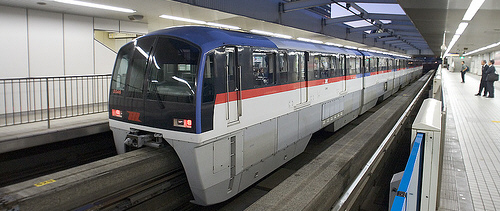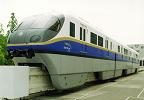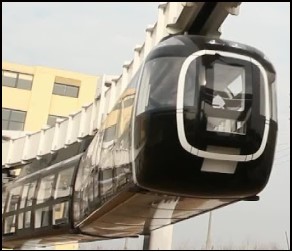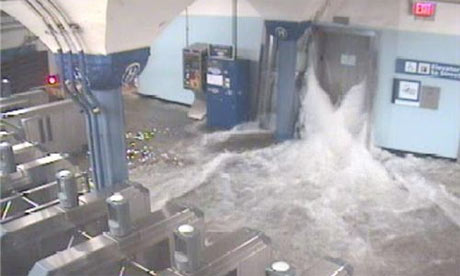Urban Monorail System Manufacturers
Monorails Australia is only concerned with proven high-capacity monorail systems that have at least one current operational example.
Ideally trains must offer 'walk-through' capability so a passenger or security guard can walk the length of the train during normal operation.
Presently this limits us to the manufacturers listed on this page.
Intamin Transportation (ITL)
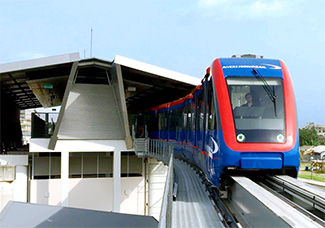 An Intamin "P30" system in Port Harcourt, Nigeria Intamin Transportation. |
Intamin systems are in operation in Moscow, Port Harcourt (Nigeria), Calabar (Nigeria), Ashgabat (Turkmenistan), Xian (China), Ningbo (China), Da Nang (Vietnam). Another is under construction in Bologna. A new type is planned for release soon which allows full walk-through access.
(Intamin's systems generally have two rails close together but are generally considered to still be a 'monorail'.)
Intamin P100 monorail Intamin Transportation.
Intamin P100 Train Characteristics
- Length of a 4-car train is 26 meters.
- Width of the carriages is 2.65m compared to about 2.6m for a tram or 2.9m for a normal train carriage.
- Maximum operational speed is 80 km/h.
- Rail is 0.8m high.
- 500 passengers per 4-car train.
- 30,000 people per hour per direction.
- Option of automatic driverless operation.
- On-board back-up power supply.
Note: Since March 2018 Monorails Australia represents Intamin Transportation on selected projects.
CRRC Suspended Monorails
CRRC Sifang Suspended Monorail
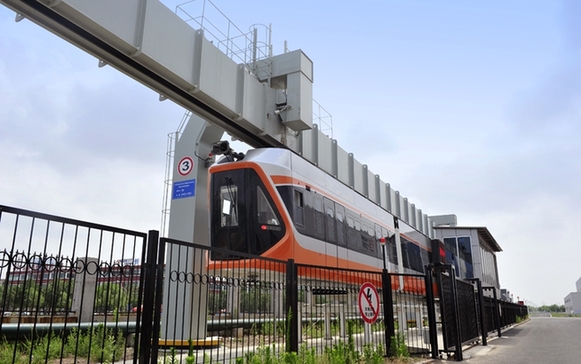 The CRRC Suspended Monorail products follows the French SAFEGE design. |
A prototype of suspended monorail train rolled out in CRRC Sifang recently. The max. Speed of the train is 70 km/h, the fastest of its kind in China. Driven by a permanent magnet motor, the experimental train runs along an overhead monorail.
The train can be composed of three or five train cars, with a passenger transport capacity of 300 and 510 people, respectively.
The train has a strong climbing ability with a maximum inclining in an altitude up to 100 meters over a length of 1,000 meters.The monorail system is suitable for passenger transport in scenery areas, mountainous regions and urban areas where road traffic is heavy.
CRRC Sifang based in Qingdao city, Shandong province, East China, is undertaking China's first suspended monorail project in Hancheng city, Northwest Shaanxi province. The construction of the line designed to stretch 55 km began in November last year. The line running in south-north direction through the city links with the city's airport, and threads through a number of scenic and historical sites along the city.
|
The CRRC Sifang Suspended Monorail has a fully walk-through interior. |
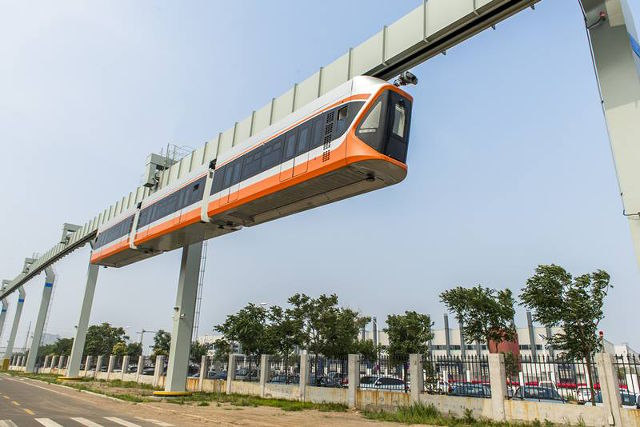 The CRRC Sifang skytrain in operation above Hancheng City, northwest Shaanxi Province. |
|
CRRC Sifang monorail concept. |
CRRC Chengdu Suspended Monorail
|
Another CRRC Suspended Monorail product. The prototype shown had a panda theme. |
|
A key feature of the Chengdu product is the use of batteries which re-charge at the stations. This means that power does not need to be supplied to the whole guideway. |
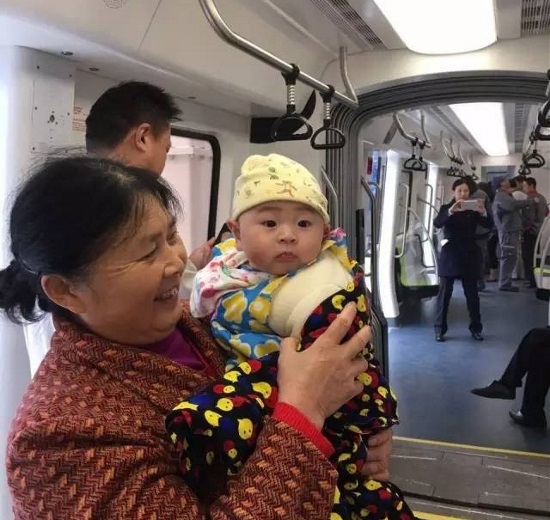 This driverless, automated train rolled off the production line in December 2016. It has doors at each end for train-to-train evacuation. China's first unmanned “Sky Train” rolled off the production line in Ziyang, Southwest China's Sichuan province |
| Configuration (3 cars) | +Mc=T=Mc+ |
| Configuration (2 cars) | +Mc=Mc+ |
| Line voltage | 750V DC |
| Design speed | 60-80 km/h |
| Seating capacity per car | 90-110 |
| Length per train (2 cars) | 19,690 mm |
| Width | 2,300-2,650 mm |
| Height | 3,120 mm |
| Max. gradient | 10.4 % |
| Min. curve negotiation radius | 30 m |
| Year first built | 2016 |
| Interior | Fully walk-through |
- CRRC Chengdu website
- YouTube. Another prototype train has a 'panda' theme.
Hitachi Monorail Trains
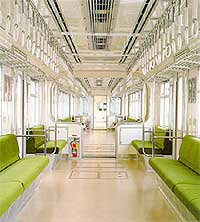 |
An interior of a Hitachi monorail train. Note the wheels are entirely under the floor. The walk-through nature of these carriages is optimised for maximum passenger loading and ease of entering and leaving the carriages. (Image: Hitachi
Rail). Our preference is for side-by-side seating that allows passengers to look out the windows. |
Hitachi Monorail Types
Hitachi produce three sizes of monorail train:
- Small: About 46 persons per carriage. Maximum speed is 60 km/h. Minimum curve radius is 60m. Length of a 4-car train is 38 meters.
- Medium: About 95 persons per carriage. Maximum speed is 80 km/h. Minimum curve radius is 100m. Length of a 4-car train is 57 meters. These are the world's second largest monorails.
- Large: 110 persons per carriage. Maximum speed is 80 km/h. Minimum curve radius is 100m. Length of a 4-car train is 59.5 meters. These are the world's largest monorails.
Hitachi Monorail Capacity per Hour
The following is the capacity per hour per direction for eight carriage trains with three minute headway:
- Small: 7,360 passengers / hour / direction.
- Medium: 15,600 passengers / hour / direction.
- Large: 18,160 passengers / hour / direction.
Hitachi Monorail Styling
In recent years Hitachi has produced monorails for a range of cities in several different styles.
Generally the cities where Hitachi monorails have been installed have not been particularly concerned with aesthetics of the pillars which has led to some poor design. In Australia the pillar design would have to be improved.
Naha Osaka Monorail (Japan)
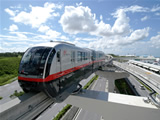 |
This monorail opened in 2003 and has two-carriage monorail trains. (Image: Hitachi
Rail). You can visit the Okinawa monorail on google street view. Walk along under the monorail and see how sharp curves and long spans are handled by Hitachi. We believe we can improve the aesthetics of a monorail system with better stations, improved pillar design and more vegetation under the monorail. |
Chongqing Monorail (China)
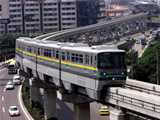 |
This 'Large' Hitachi monorail was opened in 2005 and has four-carriage monorail trains. System length is 75 km including several tunnels and large bridges. (Image: Hitachi
Rail) |
Palm Jumeirah Dubai Monorail (UAE)
 |
This 'Medium' Hitachi monorail opened in 2009 and has three-carriage monorail trains. (Image: Hitachi
Rail) Track pillars and support rail is the best yet seen for a Hitachi project proving it can be done. |
Recommended Hitachi Monorail for Australia
If Hitachi was selected to provide monorails in Australian cities we recommend using the 'Medium' or 'Large' sized trains. If the trains were automated (like at Daegu) we would like to see passengers being able to stand at the front of the train.
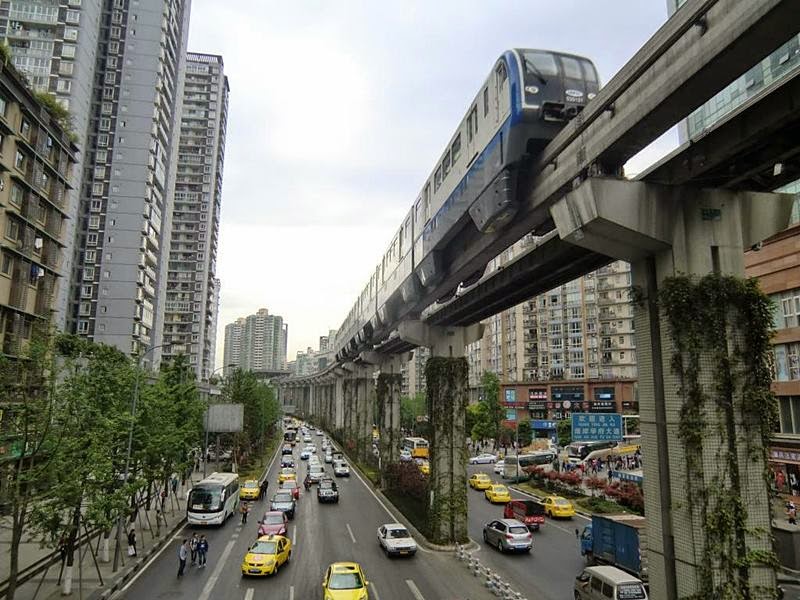
Chongqing Monorail. Note that in this image there are no unsightly cables under the guide-way which indicates this is not essential. (Image: www.ritebook.in) |
Safety
See Safety section.
Urban Monorail Videos
A Stylish New Monorail
This video shows how a Bombardier monorail could be rolled out over congested roads to provide new public transport. (Bombardier sold its transportation business to Alstrom in 2021)
|
A June 2011 Bombardier presentation to the City of Rio de Janeiro for an integrated transit project in Barra da Tijuca featuring a monorail that would be ready for the 2016 Olympic games. |
Bombardier Innovia 300 Video
|
Bombardier Innovia 300 Video. (vimeo.com/65368766) |
Minimal Advertising
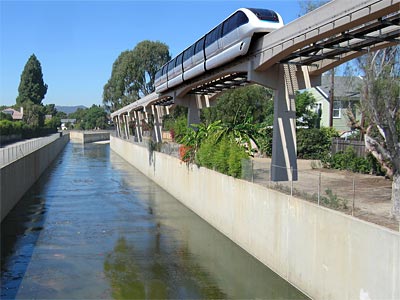
Artists impression of an LA monorail running over the flood channels. (http://lavisions.blogspot.com.au) |
It is suggested that Monorail trains, stations and pillars carry minimal advertising.
This needs to be written in to key contract documents to prevent future operators covering monorail infrastructure with unsightly billboards which would degrade the aesthetics of the system. This would still leave open the possibility of selling naming rights on each train which would allow the name and logo of the sponsoring company appearing on the train.
Automation
Monorails are well suited to automatic driving due to the lack of any level crossings, pedestrians or other unpredictable interruptions.
However it is anticipated that trains would generally carry at least one crew member to perform the following tasks:
- Safely closing the doors and starting the train towards the next station.
- Providing security and discouraging vandalism.
- Providing First Aid to ill passengers.
- Emergency management.
During late night or early morning operations these functions may on occasions be performed by remote control from a command room. At these times only accredited passengers may use the system.
This capacity for automation means that the system could affordably be run all day every day except for a one or two hour period in the early morning to allow for any guide-way maintenance tasks.
Capacity
Capacity depends on the time between services, the number of carriages and the loading per square meter. Loading Capacity (Passengers per hour per direction) can then be calculated.
The following data is from Hitachi Rail for their medium-sized monorail product with a loading of four person's per square meter which would be considered the maximum loading in Australia.
Note that the system can be expanded over time. Initially two-car trains could be used at 10 minute intervals and then gradually ramped up to eight-car trains every three minutes.
Eight-carriage trains would be about 100 meters long.
Passengers per hour per direction
| Headway (min) |
No. of Trains (per hour) |
2-Car Train | 3-Car Train | 4-Car Train | 8-Car Train |
|---|---|---|---|---|---|
| 3 | 20 | 3,680 | 5,740 | 7,800 | 15,600 |
| 4 | 15 | 2,760 | 4,305 | 5,850 | 11,700 |
| 5 | 12 | 2,208 | 3,444 | 4,680 | 9,360 |
| 6 | 10 | 1,840 | 2,870 | 3,900 | 7,800 |
Other Monorail Types
There are a range of other monorail types that have been used or proposed which we do not recommend.
- Urban Maglev Monorails: South Korea has built several urban transit monorails that use maglev technology. At this stage we are not clear what benefit this gives over simpler ALWEG technology. Given ALWEG has a much smaller beam size we prefer ALWEG. (High-speed maglev monorails are supported as they provide a clear benefit over other types of fast-rail.)
- Double Flanged Monorails: The first known rail system built with one rail was built in Wuppertal, Germany, in 1901. This system has large gantries that support an overhead rail that the monorail vehicle hangs from. This system is of historical interest but we would not recommend it in Australia.
- Urbanaut Monorails: Urbanaut has been used for the Wolmi system in Incheon, South Korea. This has now been abandoned raising serious questions about this technology. Urbanaut also proposes very high speed 'semi-maglev' rubber-tired monorails which no other established manufacturer is offering.
- Low-capacity monorails without a walk-through design and systems which have not been proven to work.
Australia's Small Tourist Monorails
Australia has some experience with small tourist monorails. While these are tiny compared to the large commuter monorail systems we are talking about on this site they have operated successfully in their designated roles.
These monorails do not allow passengers to move from carriage to carriage through the train. In our view this creates an unacceptable safety risk for passengers in the event of fire or other problems on the monorail vehicle.
We do not recommend these types of small monorail for urban transit systems.
- Sydney's Metro Monorail. The Sydney tourist monorail carried 4 million passengers per annum around its short loop of track for 25 years despite only seating 48 passengers per train. This monorail was closed down on 30th June 2013.
- The Seaworld Monorail. This monorail suffers from travelling at below walking pace and having doors that must be manually opened one at a time by the driver!
- The Oasis-Broadbeach Monorail at Broadbeach. This 25 year-old monorail re-opened in December 2014 after refurbishment. Oasis Monorail web page.
